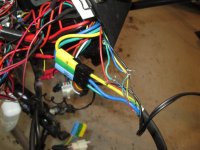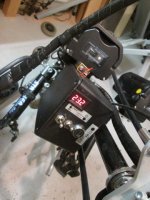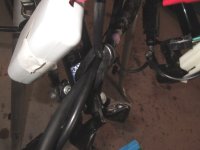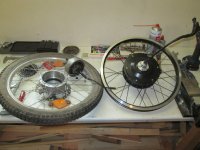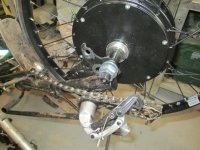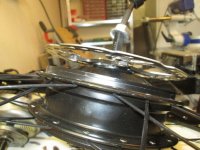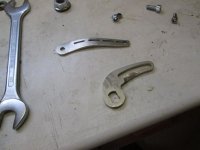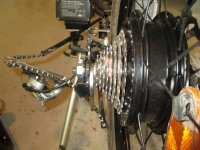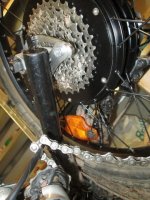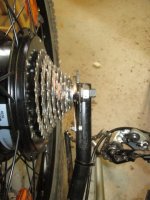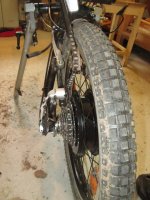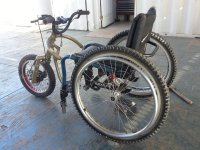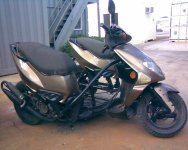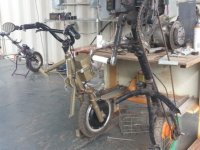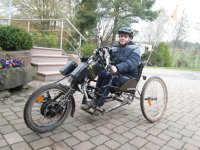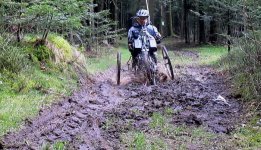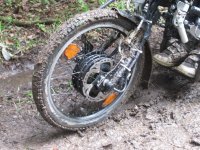handbike_electric
1 mW
- Joined
- May 5, 2016
- Messages
- 12
Hi there,
I just want to tell everybody interested about upgrading an electically supported Stricker handbike (wheelchair tricycle) for way better off road capabilities, including changing the motor to solve thermal problems. This included also solving a good amount of mechanical problems. The idea is to share my experience and to help others.
Due to an accident, our son requires a wheel chair. He always liked and still likes riding through mud and pretty serious off road sections.
Impossible for a wheel chair? Yes
So we looked for a solution. First try was a non electric handbike, manufactured by the German Company Stricker, consisting of one wheel attaching to a wheel chair.
We made quite a few modifications for better off road capability:
- removing front tires from wheel chair for better ground clearance
- off road tire to the hand bike
- longer wheel base (rear axle behind end of the seat) for better stability and for more weight onto the front tire
- widening the track width by adding adapters of about 15cm to each side, now having slightly more than 1m in total for more side stability
- adding a stainless steel tow rope and connection rings (became helpful several times yet)
- replacing the mechanical disc brake with a hydraulic Shimano SLX with the cool tech laminated aluminium / steel disc
However, this did not really work. A teenager getting maybe 40 Watts out of his arms in a hilly area with pretty steep inclines on very muddy ground does not provide much fun. So we upgraded the handbike by the standard solution offered by Stricker. This consists of 36V LiIon batteries, 15A controller, pedal assist and a 6km/h limited hand switch. The motor is (was) a Bafang 8fun 250W geared motor. There was an Arduino installed to control the controller, doing more or less what the Cycle Analyst does.
We had pretty much fun on this, e.g. in northern Italy on the Ponale Road https://de.wikipedia.org/wiki/Ponalestraße.
Attached are some pictures we took:
View attachment 7

View attachment 5
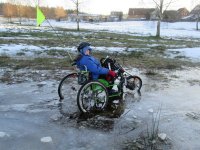

However, we got more and more problems, due to motor overload.
We killed the motor at least twice. Replacement we got (was a used one, we got if for free after warranty so no complaints) already hat dark burnt windings and loose hall sensors... Pretty sure it already was pre damaged, smelled electric. Used Epoxy to reattach the halls. When getting aware of the problem, we even installed a ATF cooling. After a short while, this engine again was killed. Smoked on the bench when only spinning slowly.
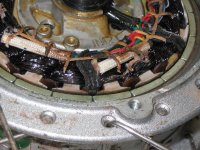


So we needed to really solve the issue. How I will explain in the next post.
I just want to tell everybody interested about upgrading an electically supported Stricker handbike (wheelchair tricycle) for way better off road capabilities, including changing the motor to solve thermal problems. This included also solving a good amount of mechanical problems. The idea is to share my experience and to help others.
Due to an accident, our son requires a wheel chair. He always liked and still likes riding through mud and pretty serious off road sections.
Impossible for a wheel chair? Yes
So we looked for a solution. First try was a non electric handbike, manufactured by the German Company Stricker, consisting of one wheel attaching to a wheel chair.
We made quite a few modifications for better off road capability:
- removing front tires from wheel chair for better ground clearance
- off road tire to the hand bike
- longer wheel base (rear axle behind end of the seat) for better stability and for more weight onto the front tire
- widening the track width by adding adapters of about 15cm to each side, now having slightly more than 1m in total for more side stability
- adding a stainless steel tow rope and connection rings (became helpful several times yet)
- replacing the mechanical disc brake with a hydraulic Shimano SLX with the cool tech laminated aluminium / steel disc
However, this did not really work. A teenager getting maybe 40 Watts out of his arms in a hilly area with pretty steep inclines on very muddy ground does not provide much fun. So we upgraded the handbike by the standard solution offered by Stricker. This consists of 36V LiIon batteries, 15A controller, pedal assist and a 6km/h limited hand switch. The motor is (was) a Bafang 8fun 250W geared motor. There was an Arduino installed to control the controller, doing more or less what the Cycle Analyst does.
We had pretty much fun on this, e.g. in northern Italy on the Ponale Road https://de.wikipedia.org/wiki/Ponalestraße.
Attached are some pictures we took:
View attachment 7

View attachment 5


However, we got more and more problems, due to motor overload.
We killed the motor at least twice. Replacement we got (was a used one, we got if for free after warranty so no complaints) already hat dark burnt windings and loose hall sensors... Pretty sure it already was pre damaged, smelled electric. Used Epoxy to reattach the halls. When getting aware of the problem, we even installed a ATF cooling. After a short while, this engine again was killed. Smoked on the bench when only spinning slowly.



So we needed to really solve the issue. How I will explain in the next post.


